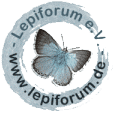

 +5Kontinente:EUAS
+5Kontinente:EUAS2. Diagnose
2.1. Erstbeschreibung
3. Biologie
3.1. Nahrung der Raupe
- [Rosaceae:] Amygdalus sp. (Mandel)
Slamka (2019: 86) berichtet: "Larva reared from almond leaves (Amygdalus sp.) - listed on the Label of the type specimen of Epicrocis anthracanthes Meyrick, 1937."
4. Weitere Informationen
4.1. Andere Kombinationen
- Salebria argyrophanes Meyrick, 1937 [Originalkombination]
4.2. Synonyme
- Epicrocis anthracanthes Meyrick, 1937
- "Keradere noctivaga (Staudinger, 1879)" sensu Leraut (214)
4.3. Taxonomie
Nach Slamka (2019: 85) handelt es sich bei Pempelia noctivaga Staudinger, 1879 um ein klares Synonym von Keradere tengstroemiella. "Keradere noctivaga (Staudinger, 1879)" sensu Leraut ist aber etwas ganz anderes, nämlich ein Synonym zu K. argyrophanes, die Leraut (2014) - völlig unberechtigt - als Synonym zu Epicrocis neftaella gestellt hatte.
4.4. Faunistik
Die Art kommt auf Zypern vor (locus typicus von Epicrocis anthracanthes ist Nikosia), fehlt aber in Europa im engeren Sinne. Locus typicus von K. argyrophanes ist Shaqlawa im Irak. Slamka (2019: 86) nennt weiter Vorkommen in der Türkei, dem Libanon und Iran.
(Autor: Erwin Rennwald)
4.5. Literatur
- Leraut, P. (2014): Moths of Europe. Volume 4. Pyralids 2. - 441 S.; Verrières-le-Buisson (N.A.P Editions).
- Erstbeschreibung: Meyrick, E. (1937): Exotic Microlepidoptera 5 (3): 65-96. [London] (Taylor & Francis).
- Slamka, F. (2019): Pyraloidea (Lepidoptera) of Europe. Volume 4. Phycitinae - Part 1. Identification - Distribution - Habitat - Biology. - 432 S., 175 Taf. mit Genitalabb., 31 Farbtaf. mit mehr als 900 Bildern zu 207 Arten; Bratislava (Eigenverlag František Slamka).









